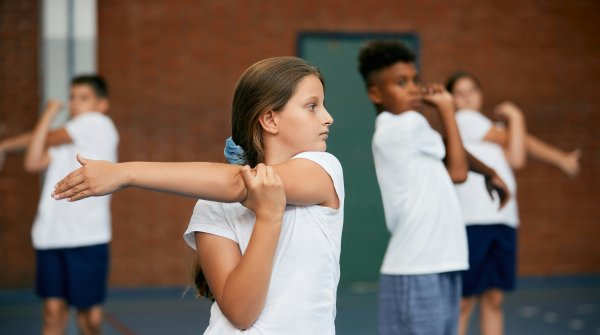
For a long time, the goal was simply to look good! Today we know that sport is also a good preventive measure and contributes overall to good health awareness. Neck pain is unpleasant and this also affects the mood - sport prevents and accordingly helps to keep the good mood in life upright.
Anyone who suffers from neck pain and tension - and in Germany that means many millions of people, at least temporarily - automatically tends to avoid painful movements because of the tension. As understandable as this is, it is not good. Because while this alleviates the symptoms, it increases the neck pain.
The easier and less painful way to fight neck pain is prophylaxis. Some simple gymnastic exercises promise success when used regularly, as you break the rigid posture in the car or office.
Place your hands on the back of your head with your fingers interlaced and push your head towards your chest. This will create a slight pulling pain that can be felt across your neck to below your shoulder blades. Stay in this position for a few seconds and then slowly raise your head back up. Do five to eight repetitions of the exercise.
So-called "soft" sports, which include endurance running, allow the muscles in the back and neck to loosen up and relax. At the same time, the muscles are well supplied with blood and warmed up, which relieves tension.
Music while running can also help to reduce internal stress and thus prevent tension and the risk of neck pain.
The run should be relaxed, without excessive effort and with a "clear head". If headaches occur, the run must be stopped and a doctor or fitness coach consulted. People who are overweight should also find out how heavy the load is before starting regular jogging.
Sports activities in water have many advantages, also when it comes to neck pain prophylaxis. Due to the high resistance (compared to air), our muscles are on the one hand more challenged, but on the other hand also spared. The reason is the automatic damping of the movement, because fast actions are hardly possible under water. In addition, the buoyancy forces relieve the joints.
Particularly in the most popular type of swimming, breaststroke, care should be taken not to hyperextend the cervical spine. This is easily achieved by partially submerging the head during the respective swimming movement. The head is tilted slightly to the side. Those who can and like crawl or backstroke should give priority to these styles.
Canoeing is ideally suited as a balancing sport for work at the PC - the rigid sitting posture here can be one of the triggers for neck pain - even though you are also sitting here.
However, the steady, powerful movement with the paddle leads to the muscles in the upper area - in the arms, shoulders, chest and back - being activated evenly. At the same time, the quiet ride over the water has a meditative and relaxing effect. For fitness and endurance, this sport is a real godsend anyway.
There are few sports in which posture is as important as in dancing. The body is stretched and permanently held in tension.
"You face your partner with your head held high; carelessness is not tolerated. This body tension is also required, for example, in many strength exercises or in horseback riding, but only dancing guarantees compliance with the rules.
Here, too, the neck-friendly strengthening of the chest and back muscles is accompanied by a psychological effect: dancing is fun. Against this, neck pain doesn't stand a chance.
Sport and regular exercise help against neck pain. Prevention plays an overriding role. Doing sports is generally good, but you will only change things permanently if you are active on a regular basis. This will eliminate the problems with neck pain and keep you fit in general.
We answer frequently asked questions about neck pain below.
Strength training, gymnastics exercises and canoeing are the best ways to help you. Jogging and dancing also help with neck pain.
Avoid drafts and warm the affected area. The following stretching exercise will also help: stretch your right arm down and lower your head to the left side for ten seconds - then do the same with your left arm and lower your head to the right side.
Regular strength training is the best way to help you. Incorporate a neck exercise into your back training - this will help you avoid pain and build strong muscles.
- ISPO awards
- Mountain sports
- Bike
- Design
- Retail
- Fitness
- Health
- ISPO Job Market
- ISPO Munich
- ISPO Shanghai
- Running
- Brands
- Sustainability
- Olympia
- OutDoor
- Promotion
- Sports Business
- ISPO Textrends
- Triathlon
- Water sports
- Winter sports
- eSports
- SportsTech
- OutDoor by ISPO
- Heroes
- Transformation
- Sport Fashion
- Urban Culture
- Challenges of a CEO
- Trade fairs
- Sports
- Find the Balance
- Product reviews
- Newsletter Exclusive Area
- Magazine






